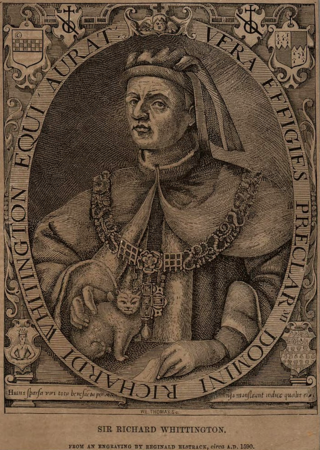Related Research Articles

Richard Whittington of the parish of St Michael Paternoster Royal, City of London, was an English merchant and a politician of the late medieval period. He is also the real-life inspiration for the English folk tale Dick Whittington and His Cat. He was four times Lord Mayor of London, a member of parliament and a Sheriff of London. In his lifetime he financed a number of public projects, such as drainage systems in poor areas of medieval London, and a hospital ward for unmarried mothers. He bequeathed his fortune to form the Charity of Sir Richard Whittington which, nearly 600 years later, continues to assist people in need.

The Tribes of Galway were 14 merchant families who dominated the political, commercial and social life of the city of Galway in western Ireland between the mid-13th and late 19th centuries. They were the families of Athy, Blake, Bodkin, Browne, Darcy/D’Arcy, Deane, Fant, French, Joyce, Kirwan, Lynch, Martyn, Morris and Skerritt. Of the 14 families, 12 were of Anglo Norman origin, while two—the Darcy and Kirwan families—were Normanised Irish Gaels.
Richard Óge Martyn was a Galway lawyer and member of the Catholic Confederates of Ireland. He was of the senior line of the Martyn family, one of the Tribes of Galway. He lived at Dunguaire Castle, Kinvarra. He worked with his brother-in-law and first cousin, Patrick D'Arcy, against the Plantation of Connaught in the 1630s, and served on the Supreme Council of the Confederate Catholics in the 1640s.
Peirce Lynch, alias Peter Lynch, fl. 1485–1486, was the first Mayor of Galway.
William Óge Martyn was the 101st Mayor of Galway.
Robert fitz Martin was a knight from Devon whose father, Martin de Turribus, was the first Norman Lord of Kemes, in what had previously been the Dyfed part of Deheubarth. Fitz Martin inherited the Lordship of Kemes from his father, and founded St Dogmaels Abbey c. 1118. He was the first of the FitzMartin line. His descendants continued to hold lands in England and Wales until the 14th century.
There have been four baronetcies for persons with the surname Blake, one in the Baronetage of Ireland, two in the Baronetage of Great Britain and one in the Baronetage of the United Kingdom. Two of the creations are extant as of 2010. The Blake Baronetcy, of Menlough in the County of Galway, was created in the Baronetage of Ireland on 10 July 1622 for Valentine Blake, Mayor of Galway in 1611 and 1630 and a member of the Irish House of Commons for County Galway. His grandfather Thomas Blake had preceded him as Mayor. The second Baronet was a member of the Irish Parliament for Galway Borough. The third Baronet represented both County Galway and Galway Borough in Parliament. The sixth Baronet was a member of the Irish House of Commons for County Galway. He was the first Catholic gentlemen of distinction to join William of Orange. The twelfth Baronet represented Galway Borough in the British House of Commons. The fourteenth Baronet was high sheriff of County Galway in 1872. See also the Blake Baronetcy of Twizell Castle below.
Andrew Lynch (Mayor), 14th Mayor of Galway, died 25 March 1523.
John Blake fitz William, third Mayor of Galway, 1487–1488.
Thomas Bodkin, fl. 1506–1507, was the first member of the Bodkin family to be elected Mayor of Galway. The Bodkins were one of The Tribes of Galway, and a sept of the FitzGerald family. He would be succeeded in office by John Bodkin fitz Richard, Richard Bodkin (1610–1611), and John Bodkin fitz Dominick (1639–1640).
James Lynch (fitz Ambrose) (fl.1574–1591) was Mayor of Galway from 1590 to 1591.
Sir Henry Lynch, 1st Baronet was an Irish baronet, knight, lawyer, and land agent. Lynch was among the first of his family to become a lawyer, and several of his younger sons followed him into this profession, as did, under his influence, Patrick D'Arcy, Richard Martyn, and Geoffrey Browne as well as many of the later generations of the Tribes of Galway.
Sir Richard Blake was an Irish politician and Mayor of Galway, fl. 1627–1648.
Máire Lynch, Countess of Clanricarde, fl. 1547.
John Bodkin fitz Richard was Mayor of Galway, 1518-19.
John Bodkin fitz Dominick was the mayor of Galway from 1638 to 1640.
Robuck French fitz John, Mayor of Galway 1582-83.
John Lynch fitz Andrew, Mayor of Galway, September 1528-September 1529. Lynch was the son of Andrew Lynch and Eleanor Martin. He had a brother, Arthur Lynch fitz Andrew, who served as Mayor from 1539 to 1540. During his term, laws were introduced which forbade a number of forms of gambling, such as dice, cards, aimed especially against apprentices and members of the Gaelic community. Those found guilty would pay twenty shillings.
Walter Blake fitz John, Bishop of Clonmacnoise, County Offaly, Ireland, died 1508.
Uilliam Seóighe, Archbishop of Tuam, died 1508. Seóighe was said to be a native of Galway town. He directly succeeded Donatus Ó Muireadhaigh, O.S.A, as Walter Blake fitz John had been appointed but not consecrated.
References
- History of Galway, James Hardiman, Galway, 1820.
- Old Galway, Maureen Donovan O'Sullivan, 1942.
- Henry, William (2002). Role of Honour: The Mayors of Galway City 1485-2001. Galway: Galway City Council. OCLC 51023721 ASIN B003NECRYW
- Martyn, Adrian (2016). The Tribes of Galway: 1124-1642